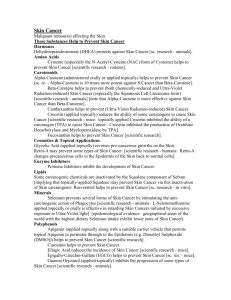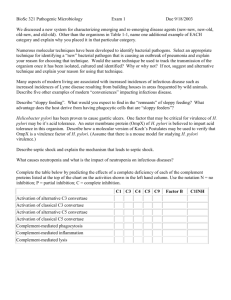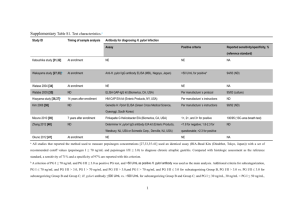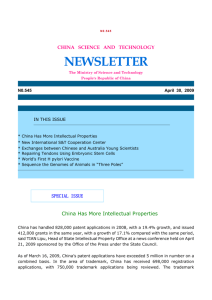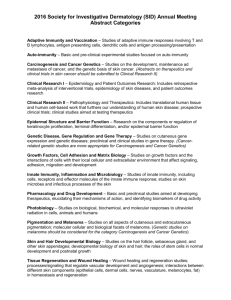Ellagic acid is a naturally occurring phenolic constituent in certain
advertisement
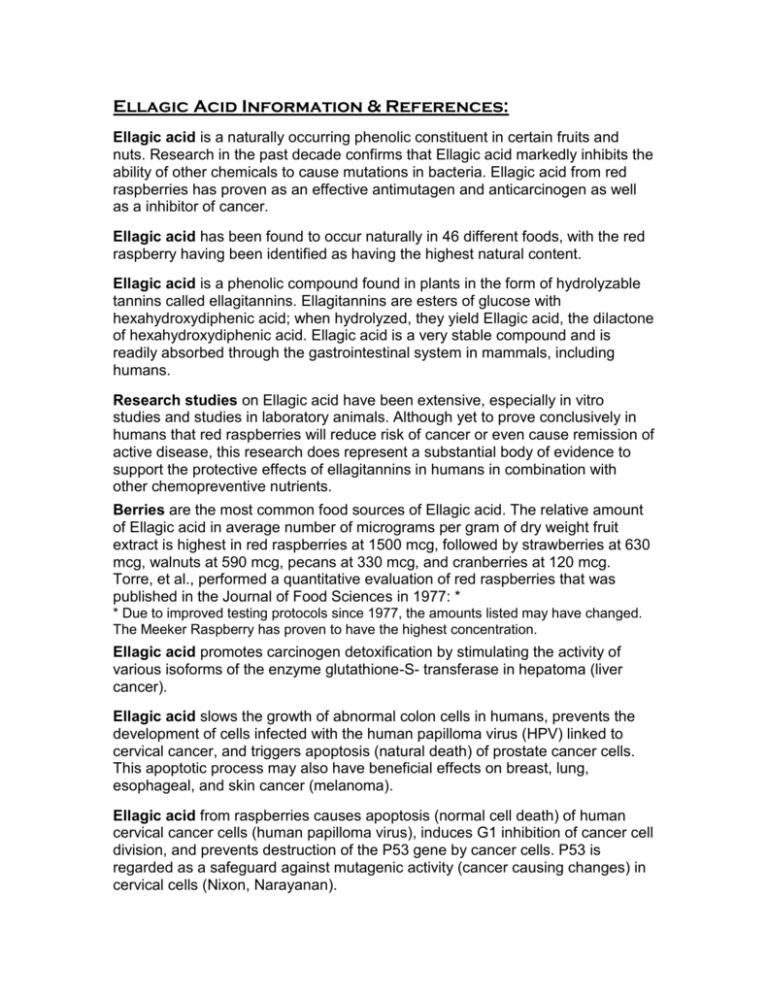
Ellagic Acid Information & References: Ellagic acid is a naturally occurring phenolic constituent in certain fruits and nuts. Research in the past decade confirms that Ellagic acid markedly inhibits the ability of other chemicals to cause mutations in bacteria. Ellagic acid from red raspberries has proven as an effective antimutagen and anticarcinogen as well as a inhibitor of cancer. Ellagic acid has been found to occur naturally in 46 different foods, with the red raspberry having been identified as having the highest natural content. Ellagic acid is a phenolic compound found in plants in the form of hydrolyzable tannins called ellagitannins. Ellagitannins are esters of glucose with hexahydroxydiphenic acid; when hydrolyzed, they yield Ellagic acid, the dilactone of hexahydroxydiphenic acid. Ellagic acid is a very stable compound and is readily absorbed through the gastrointestinal system in mammals, including humans. Research studies on Ellagic acid have been extensive, especially in vitro studies and studies in laboratory animals. Although yet to prove conclusively in humans that red raspberries will reduce risk of cancer or even cause remission of active disease, this research does represent a substantial body of evidence to support the protective effects of ellagitannins in humans in combination with other chemopreventive nutrients. Berries are the most common food sources of Ellagic acid. The relative amount of Ellagic acid in average number of micrograms per gram of dry weight fruit extract is highest in red raspberries at 1500 mcg, followed by strawberries at 630 mcg, walnuts at 590 mcg, pecans at 330 mcg, and cranberries at 120 mcg. Torre, et al., performed a quantitative evaluation of red raspberries that was published in the Journal of Food Sciences in 1977: * * Due to improved testing protocols since 1977, the amounts listed may have changed. The Meeker Raspberry has proven to have the highest concentration. Ellagic acid promotes carcinogen detoxification by stimulating the activity of various isoforms of the enzyme glutathione-S- transferase in hepatoma (liver cancer). Ellagic acid slows the growth of abnormal colon cells in humans, prevents the development of cells infected with the human papilloma virus (HPV) linked to cervical cancer, and triggers apoptosis (natural death) of prostate cancer cells. This apoptotic process may also have beneficial effects on breast, lung, esophageal, and skin cancer (melanoma). Ellagic acid from raspberries causes apoptosis (normal cell death) of human cervical cancer cells (human papilloma virus), induces G1 inhibition of cancer cell division, and prevents destruction of the P53 gene by cancer cells. P53 is regarded as a safeguard against mutagenic activity (cancer causing changes) in cervical cells (Nixon, Narayanan). Unpublished research at the Hollings Cancer Center shows that one cup of raspberries per week will stop prostate cancer growth for a period of up to one week. Their studies reveal that Ellagic acid from red raspberries is readily absorbed through the gastrointestinal tract. Ellagic acid retains its potency after heating, freezing and concentration processing. So whether consumed fresh, in juices, fruit spreads, preserves or sorbets, red raspberry has been recommended as a beneficial part of any healthy diet. Inhibition of carcinogenesis by Ellagic acid has been demonstrated in animals with esophagus, tongue, lung, colon, liver, and skin tumors. Ellagic acid inhibits the initiation of tumors through a number of mechanisms, including inhibition of metabolic activation of carcinogenic compounds (such as polycyclic hydrocarbons, nitroso-containing chemicals or food preservatives, and aflatoxins) into forms that induce cell DNA damage. Ellagic acid acts as a scavenger to "bind" cancer-causing chemicals, making them inactive. It inhibits the ability of other chemicals to cause mutations in bacteria. In addition, Ellagic acid from red raspberries prevents binding of carcinogens to DNA, and reduces the incidence of cancer in cultured human cells exposed to carcinogens. Ellagic acid has been shown to inhibit chemically induced cancer in the lung, liver, skin and esophagus of rodents, and TPAinduced tumor promotion in mouse skin (Stoner). Ellagic acid elicits a dose-dependent bactericidal effect in H. pylori cultures, the bacteria thought primarily responsible for the development of gastric ulcers (Chung). Ellagic acid is an effective inhibitor of lung and esophageal tumors in mice (Stoner). Ellagic acid inhibits lipid peroxide and liver hydroxy proline and rectifies liver pathology in laboratory animal hepatotoxcity induced by carbon tetrachloride (Thresiamma). Cancer can affect DNA by covalent bonding of the carcinogen to the DNA molecule. Ellagic acid inhibits mutagenesis and carcinogenesis by forming adducts with DNA, thus masking binding sites to be occupied by the mutagen or carcinogen (Teel). Ellagic acid treatment of preweanling mice before an injection of B(a)P diolepoxide caused a 44-75% inhibition in the number of diol-epoxide-induced lung tumors (Chang). Ellagic acid inhibits N-nitrosomethylbenzylamine (NMBA) tumorigenesis in the esophagus of F-344 rats. Ellagic acid inhibited the development of both preneoplastic and neoplastic lesions by 25-50% (Daniel and Stoner). Ellagic acid reduced the number of altered foci and the incidence of hepatocellular neoplasms in rats with liver cancer induced by N-2fluorenylacetamide (Tanaka). There is clinical evidence that Ellagic acid may inhibit tumors of the prostate and cervix. Preliminary studies in volunteers indicate Ellagic acid shows up in cervical tissue after oral ingestion of red raspberries. One study will evaluate women with atypical squamous cells of undetermined significance (ASCUS) in which there is neither treatment nor clinical evaluation available. ASCUS represents as much as 10% of all Papanicolaou smears in the US and represents approximately 5 million females. In this population, women infected with human papillomaviruses (HPV) types 16 and/or 18 are at the greatest risk of developing cervical cancer at some stage in their lives. This population represents approximately one million women in the United States alone, and in India is one of the two major cancers affecting women. Ellagic acids do more than prevent cancer. Berries may also help prevent heart attacks because they contain a natural form of aspirin called salicylates. British researchers analyzed the blood of subjects who were not taking any form of aspirin or drugs containing salicylates. They found salicylic acid and two related compounds present in blood, presumably from dietary sources, including raspberries and blackberries. Researchers at the National Center for Health Statistics (NCHS) in Hyattsville, Maryland established a connection between reduced risk of heart attack and increased intake of salicylates. They found that during a 10 year period beginning in 1960, when heart attack rates began to decline, non-aspirin salicylate consumption went up due to salicylate in processed foods which used a synthetic version to add flavor and aroma. Ellagic acid is pharmacologically active and has been found to control hemorrhage in animals and in humans, presumably as a result of its ability to activate Hageman factor. Animal tests suggest that red raspberry may reduce levels of glucose (blood sugar) in animals, and therefore may help in the management of diabetes. Ellagic acid inhibits lipid peroxidation necrosis of skin flaps, enhancing preservation of grafting procedures (Ashoori). Ellagic acid has a marked inhibitory effect on acid secretion and the occurrence of stress-induced gastric lesions (Murakami). Ellagitannins are also believed by herbalists to be effective in treating diarrhea, nausea, vomiting and morning sickness in pregnancy. Herbalists do not, however, recommend you use red raspberry for this purpose at home even though red raspberry leaves are included in several herbal pregnancy formulas sold in the United States for women with a history of miscarriage or difficult pregnancy for the purpose of regulating uterine contractions, morning sickness, hot flashes, diarrhea (use weak tea for infants), and for reducing excessive menstrual flow. The herb is also used as a gargle for sore throats. SELECTED REFERENCES Ahn D et al. The effects of dietary ellagic acid on rat hepatic and esophageal mucosal cytochromes P450 and phase II enzymes. Carcinogenesis 17:821-828, 1996. Ayrton AD et al. Antimutagenicity of ellagic acid towards the food mutagen IQ: investigation into possible mechanisms of action. Food Chem Toxicol 30(4):28995, 1992. Barch DH et al. Ellagic Acid Induces NAD(P)H:Quinone Reductase Through Activation of the Antioxidant Regulatory Element of the Rat NAD(P)H:Quinone Reductase Gene. Carcinogenesis 15:2065-2068, 1994. Bhargava UC et al. The mechanism of blood pressure depression by ellagic acid. Proc Soc Exp Biol Med 132(2):754-6, 1969. Castonguay A et al. Antitumorigenic and antipromoting activities of ellagic acid, ellagitannins and oligomeric anthocyanin and procyanidin. Int J Oncology 10, 367-373, 1997. Chung, JG Microbios 1998;93(375):115-27 Inhibitory actions of ellagic acid on growth and arylamine N-acetyltransferase activity in strains of Helicobacter pylori from peptic ulcer patients. Department of Medicine, China Medical College, Taiwan, Republic of China. Arylamine N-acetyltransferase (NAT) activity in Helicobacter pylori was inhibited by ellagic acid, a possible chemopreventive drug. The NAT activity was determined using an acetyl CoA recycling assay and high pressure liquid chromatography. Inhibition of growth studies using H. pylori demonstrated that ellagic acid elicited a dose-dependent bactericidal effect in H. pylori cultures, i.e. the greater the concentration of ellagic acid, the greater the inhibition of growth of H. pylori. The IC50 value was 1 mM for inhibition of growth of H. pylori. Cytosols or suspensions of H. pylori with and without selected concentrations of ellagic acid co-treatment showed different percentages of 2-aminofluorene and paminobenzoic acid acetylation. The data indicated that there was decreased NAT activity associated with increased ellagic acid in H. pylori cytosols and intact cells. For the cytosol and intact bacteria examinations, the apparent values of K(m) and Vmax decreased after co-treatment with 1 mM ellagic acid. This report is the first demonstration of ellagic acid inhibition of arylamine NAT activity and ellagic acid inhibition of growth in the bacterium H. pylori. Constantinou A et al. The dietary anticancer agent ellagic acid is a potent inhibitor of DNA topoisomerases in vitro. Nutr Cancer 23(2):121-30, 1995. Daniel EM et al. The effects of ellagic acid and 13-cis-retinoic acid on Nnitrosobenzylmethylamine-induced esophagal tumorigenesis in rats. Cancer Lett 56:117-124, 1991. Lesca P. Protective effects of ellagic acid and other plant phenols on benzo(a)pyrene-induced neoplasia in mice. Carcinogenesis 4:1651-1653, 1983. Muktar H et al. Ellagic acid: A potent naturally occurring inhibitor of benzo[a]pyrene metabolism and its subsequent glucuronidation, sulfation and covalent binding to DNA in cultured BALA/c mouse keratinocytes. Carcinogenesis 5: 1565-1571, 1984. Nixon DW. Alternative and complementary therapies in oncology care. J Clin Oncol 17(11 Suppl):35-7, 1999. Nixon DW. Prostate cancer and nutrition. JSC Med Assoc 96(2): 85-6, 2000. Nixon DW. Preventive medicine in the year 2000. Prev Med 30(1): 1-2, 2000.) Perchellet JP et al. Antitumor-promoting activities of tannic acid, ellagic acid, and several gallic acid derivatives in mouse skin. Basic Life Sci 59:783-801, 1992. Rao CV et al. Chemoprevention of colon carcinogenesis by dietary administration of Piroxicam, Difluoromethylornithine, 16beta-Fluoro-5- androsten-17-one, and Ellagic Acid individually and in combination. Cancer Research 51: 4528-4534, 1991. Rommel A et al. Red raspberry phenolic. Influences of processing, variety and environmental factors. In: Ho C-T, Lee CY, Huan M-T Eds. Phenolic Compounds in Food and Their Effects on Health I. Analysis, Occurrence & Chemistry. Washington DC. American Chemical Society. 259-286, 1992. Rossi M et al. The crystal and molecular structure of ellagic acid dihydrate: a dietary anti-cancer agent. Carcinogenesis 12:2227-32, 1991. Singletary K et al. Ellagic acid effects on the carcinogenicity, DNA-binding and metabolism of 7,12-dimethylbenz[a}anthracene (DMBA). In Vivo 3: 173-176, 1989. Smart RC et al. Effect of ellagic acid and 3-O-decylellagic acid on the formation of benzo[a]pyrene-derived DNA adducts in vivo and on the tumorigenicity of 3methylcholanthrene in mice. Carcinogenesis 7(10):1669-75, 1986. Tanaka T et al. Inhibitory effect of ellagic acid on N-2-fluoenylacetamide- induced liver carcinogenesis in male AC1/N rats. Jpn J Cancer Res (Gann) 79:12971303, 1988. Tanaka T et al. Inhibition of 4-nitroquinoline-1-oxide-induced rat tongue carcinogenesis by the naturally occurring plant phenolics caffeic, ellagic, chlorogenic and ferulic acids. Carcinogenesis x14(7):1321-5, 1993. Teel RW. Ellagic acid binding to DNA as a possible mechanism for its antimutagenic and anticarcinogenic action. Cancer Lett 30(3):329-36, 1986. *Disclaimer: The above information is for educational purposes only. It is not intended to diagnose or prescribe. If you have a medical condtion, we recommend that you see your health care provider. For more information email support@altcancer.com.
